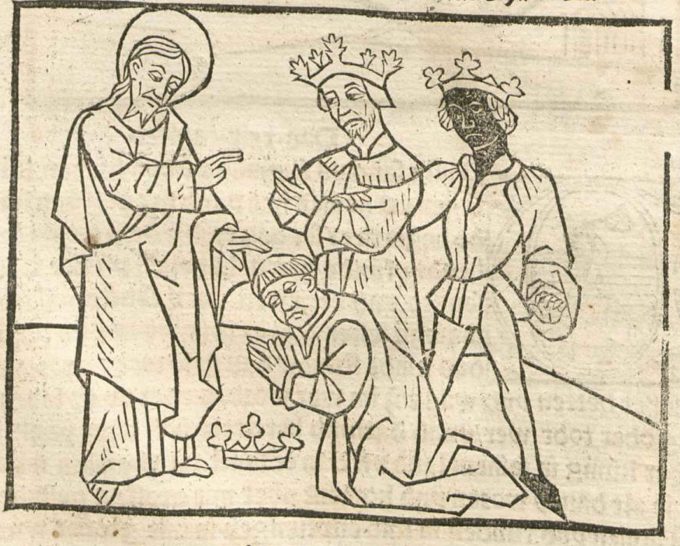Around 1370 the Carmelite scholar Johannes of Hildesheim took on an ambitious task: to compile an authoritative account of the Three Kings (a.k.a. the Three Magi) from disparate biblical, historical, and legendary sources. By this point the outline of their story was well-established, but many details were disputed. John’s work was very popular in its own time and did much to establish a single authoritative version of the legend, but it was eventually forgotten, only to be rediscovered in the early nineteenth century.
As had earlier writers, John seeks to deal with the apparent paradox of Christian veneration of pagan figures by firmly grounding the Magi in Christian traditions and institutions. He also makes the story relevant by tying it to more recent events, most notably the Crusades and Mongol expansion of the previous two centuries. In his account the Magi fulfilled various prophecies. They each learned of the star over Bethlehem and journeyed from their respective lands. They met outside Jerusalem and took part in the Adoration, and, having been warned in a dream, they fled Bethlehem rather than inform the wicked King Herod about the baby Christ. Travelling together to India, they founded a chapel on the Hill of Vaus, the site where the star had first been seen. They made a pact to return every year and, eventually, to be buried there. The Apostle Thomas, whose task was to spread the Gospel to the east, found them here, baptized them, and named them archbishops, and after his death they appointed spiritual and temporal leaders in their region. These included the legendary Prester John as well as various other nobles of Vaus to whom they bequeathed all of their possessions and lands. Upon their deaths they effected a miracle: the first two to die kindly moved over to make space for the body of the third.
After digressing to discuss various heretical cults, John narrates how their remains ended up in Cologne. He starts with their legendary discovery sometime around 300 CE by St. Helena, the famously Christian mother of Emperor Constantine, follows them to Milan, and finally describes how in 1164 Archbishop Reinald von Dassel brought them to Cologne, where they proved a great draw for pilgrims and enhanced the Archbishop’s prestige.

Both of the images here come from a late fifteenth-century German translation of the text printed by Heinrich Knoblauchtzer, who clearly hoped he would profit from adding high-quality illustrations to a popular work. The picture at the top of the page shows St. Thomas consecrating the Kings and appointing them bishops of India. The second picture has been described as depicting the founding of the chapel at Vaus, but the caption and accompanying text make it clear that it shows the Magi handing over their possessions to the local lords of Vaus. We are told their descendants, intriguingly represented by the Black traveller, later built the mighty fortress in Acre, an important site during the Crusades. What is particularly noteworthy is that these are the only two depictions of a Black Magus in the entire work. John is not ambiguous about the Kings’ origins: he identifies Balthasar as the king of Sheba, Melchior as the king of Nubia and Arabia, and Caspar as the king of the legendary isle of Tharsis and a “black Ethiop” to boot! Nevertheless, the ten other depictions of the Kings give them all light skin. Illustrations at the time were done separately from the text, and illustrators were generally given minimal guidance, so this shows us that at least some illustrators in Knoblauchtzer’s workshop were aware of a new trend, while others were either unaware or uninterested. In these differing depictions in a single publication we can see the diffusion of the imagery of a Black Magus in visual media.
Jeff Bowersox
Deutsch
Source: John of Hildesheim, Historia trium regum Strasbourg: Heinrich Knoblochtzer, ca. 1483), 63, Bayerische Staatsbibliothek Munich 2 Inc.s.a. 743 i.

The legend of the Three Kings (1483) by Jeff Bowersox is licensed under a Creative Commons Attribution-ShareAlike 4.0 International License.
Permissions beyond the scope of this license may be available at https://blackcentraleurope.com/who-we-are/.
